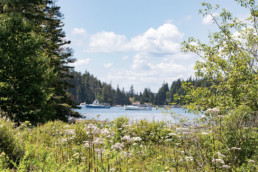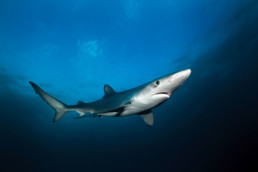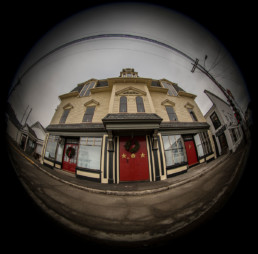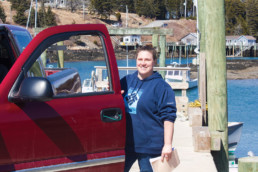The Unique Environment of Island Forests
The Unique Environment of Island Forests
Sea, salt, cool fog, and wind shape the wooded areas of islands
Story by Catherine Schmitt and photos by Jack Sullivan
Imagine being at sea for weeks, months, or years, seeing only blue, gray, and the foaming white of cresting waves. Imagine smelling only salt, minerals, fish, and then, one day, catching the faintest scent of something different, like honey mixed with cinnamon and turpentine. On the horizon, a black blur slowly resolves into solid green.
Trees, land, destination! Rock islands tufted with dark green spires, their needles sending aromatic messages into the wind. Forest. Earth. Home!
Maine island forests share many characteristics with the great North Woods that stretch across the northern tier of the continent. But, in many other ways, island forests are unique. Surrounded and shaped by the sea, island woods are influenced by cool temperatures, wind, waves, salt spray, and fog.
Especially northeast of Penobscot Bay, the coast experiences twice as many hours of fog because cold currents from the Arctic flow close to shore. Boreal evergreens like spruce and balsam fir flourish in the cool, moist climate. Salt-tolerant, fast-growing white spruce grow right along the seaward edge, their roots holding island soil in place. Red spruce, balsam fir, paper birch, yellow birch, and red maple are common.
These trees attract sharp-shinned hawks, yellow-bellied flycatchers and flickers, warblers, chickadees, and crossbills. Leach’s storm-petrels burrow in fallen logs and roots. Eagles nest on white pine branches high above the canopy.
Mammals are few on distant, isolated islands (meadow voles, masked shrews, maybe mink) but common on nearshore islands and include moose, deer, muskrat, porcupine, raccoon, red squirrel, snowshoe hare, and otters.
Mammals and birds feeding on mussels and urchins leave shells strewn about the woods, a small but not insignificant influx of marine nutrients.
The understory might include small firs, alder, sheep laurel, blueberry, and, right under the spruce, twin-petaled white flowers of dwarf enchantress-nightshade. But mostly, there are lichens—bloodstain lichens, granular lichens, budding tube lichens, crottle and beard lichens crusting ocean-facing trees—and moss. Big red-stem moss, stairstep and broom mosses, three-lobed and leafy liverworts cover the ground, and overtake fallen trees, of which there are many.
As Island Institute founder Philip Conkling wrote in Islands in Time, these forests are “the realm of the rugged.”
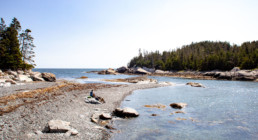
Islands bear the brunt of coastal storms, and windthrown trees define island forest form and function. As trees along the edge die and blow over, wind reaches more of the interior, blowing more trees down, creating gaps in the overstory where sunlight pours in and reaches plants on the forest floor. As a result of such intense and frequent disturbances, island forests tend to be younger, especially around their edges.
Maine island forests are also younger because so many of the islands were cleared in the last few hundred years.
In the Dawnland home of the Wabanaki, islands were and continue to be places for hunting, fishing, foraging, creating, living. But historically, indigenous people lost access as islands were among the first places colonized by Europeans.
In the warmer, drier region south of Penobscot Bay, colonists quickly cut large white pines along with hardwoods like oak, chestnut, walnut, and hickory. Later, they cleared spruce and fir on northern islands to make way for farming and sheep grazing, and trees were cut and sent to shipyards, lime kilns, and paper mills. They re-named islands after what they took from the forests: Hardwood, Clapboard, Stave.
Land clearing peaked in the second half of the 19th century. The varied histories of human use, along with differing geology, soil, climate, and exposure to wind and waves, along with the mystery of forces beyond human knowledge, mean that each island’s forest is unpredictably unique.
Take, for example, the small, domed island called Bar Island, at the head of Somes Sound on Mount Desert Island. Pines and oaks more than a hundred years-old shade an understory of scattered fir and birch. Standing dead trees are half-rotted, hole-ridden snags; others lay fallen across the ground and each other. Moss grows on stacked stones of an old well, and trees are choked by garden plants gone wild on the flat terrace of a one-time piazza. The mix of red and white pine and oak is unusual in the Acadia archipelago.
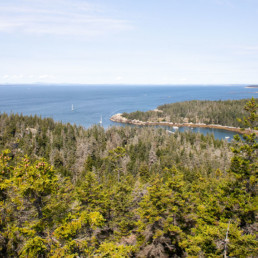
Just the slightest difference can create contrasting forests, even on adjacent islands. White spruce typically grows only along the most seaward edge, as on Little Moose Island, but nearby Schoodic Island is all white spruce. Little Duck Island is dominated by balsam fir, but spruce dominates on neighboring Great Duck Island, which is flatter and thus more exposed to salt spray.
The sea, of course, is the strongest influence. Island forests can be thick with fog even on days when the mainland is hot and dry. On Bald Porcupine Island, northern white cedars, typically found in wet areas, have grown on high, dry ground for 200 years, perhaps drawing their needed moisture from fog.
Fog and the relatively cool temperatures of the Gulf of Maine allowed spruce and fir to persist on the Downeast coast even as the climate changed since the end of the last ice age. Studies of fossil pollen buried in lake and wetland sediments show that spruce has grown continuously for 2,000 years on Mount Desert Island, 5,000 years on Isle au Haut, and 9,500 years on Roque Island.
Temperatures are changing today much faster than in the past. Storms are increasing. Will spruce-fir forest continue to find refuge in the maritime air of the Maine islands?
“The eastern half of the coast, we’re going to see some major change in island vegetation,” said Glen Mittelhauser of the Maine Natural History Observatory, who led a 1990s study of Acadia islands with the help of Earthwatch volunteers. “But the last place where spruce will linger is probably on these islands.”
A follow-up study in 2018, also aided by Earthwatch volunteers, and monitoring by the National Park Service, show that Acadia’s island forests are aging but not drastically changing. But threats loom in the form of invasive plants and pests: glossy buckthorn, barberry, winter and browntail moths, and red pine scale, which has killed the red pines on Bar Island in Somes Sound.
Changes in island forests will ultimately affect the sea. Rain and snowmelt flow through the woods into streams that empty into small bays, or soaks through the ground and seep out where the forest floor meets the tideline. Fulvic acid leached from leaves picks up iron as it filters through roots and soil, supplying this important mineral to phytoplankton, seaweed, and fish.
As they turn into driftwood on the sun- and salt-baked rocks, fallen and broken trees make good perches and burrows. Driftwood attracts wood-boring crustaceans, mollusks, shipworms, and the ocean strider, an insect that attaches its eggs to floating wood. The very existence of these animals shows the evolved connections between island trees and the sea, and the many intricate relationships of forest, earth, and home.
Catherine Schmitt is the author of Historic Acadia National Park, The President’s Salmon, and A Coastal Companion: A Year in the Gulf of Maine from Cape Cod to Canada. She is a science writer with Schoodic Institute at Acadia National Park. Find more of her work at catherineschmitt.com.
The Misunderstood Shark
The Misunderstood Shark
Several species of this ancient creature make their home in the Gulf of Maine
By Dana Wilde
“Bastid took m’ hook!” Carts, a wiry guy with a cockeyed green cap and gaps in his smile, looked down at me from his precarious perch on the gunnel of the boat. I was about nine years old, and taken aback by his anger about the hook.
We were on a lobster boat off the east shore of Chebeague Island this sun-blazing summer afternoon. My father was somewhere flying fishermen in his seaplane to unknown destinations. I was stuffed away on the boat anchored in fairly shallow water within sight of Bangs Island. Carts, whose main job was hauling sardine seines, today was assigned to make sure I did not fall overboard and drown.
Having nothing else to do, he decided we’d go fishing. My experience with fishing included dropping handlines to catch pollock drifting lazily under floats at Bailey Island, and casting mackerel jigs from the wharf at Cliff Island to catch fish you could actually clean and eat. No pollock had ever come remotely close to biting off my hook. So Carts’s indignation about his hook seemed both appropriate and alarming. Though I soon realized it was mock disgruntlement, in preparation for teaching these fish a lesson they would never forget.
“OK, brothers, game’s on!” he said, or something like that, and set about changing line weight and hook, and maybe bait too.
What kind of a fish bites a hook clean off a handline?
Pretty soon Carts had a pretty powerful tug on his line. “Goddamn dogfish,” he said in between grunting, swearing, and manipulating his line in ways I had never imagined possible. Dogfish I had heard of but never seen, and imagined them to be some kind of streamlined sculpin, but less revolting.
As I watched, Carts hauled out of the green salt water a miniature shark! I was astounded. I had seen sharks on TV. And on our daily hops in the seaplane from Great Pond in Cape Elizabeth across outer Casco Bay and the Green islands to Bailey Island, my father had once or twice pointed out enormous fishes with dorsal fins motoring just beneath the surface, which he said were sharks. What kind, I never knew, but those fish were frighteningly huge, even compared to the 500-pound bluefin tunas I was used to seeing landed on the dock at Bailey Island. Until that afternoon on the boat at Chebeague, I had no idea a full-grown shark could be two feet long.
Soon a couple of other fishermen showed up and joined Carts’s fray. One after another they hauled up dogfish from the sandy bottom. After a while the deck of the boat was bloody and slippery with what seemed like dozens of gray and white, flipping, dorsal-finned sharks. Their skin felt sandpapery. Their overbite faces looked dangerous.
It’s not possible nearly 60 years later to know exactly what kind of dogfish we were catching, but a guess is they were spiny dogfish, the smallest and most abundant of the eight species of sharks seen with any regularity in Maine waters. The relatively warm summer water just off the island was the right spot for Squalus acanthias, which in summer tends to migrate north from the mid-Atlantic toward the Gulf of Maine, or south from Newfoundland as part of a subpopulation there.
Like many shark species, they move in groups segregated by sex and maturity. These spiny dogfish off Chebeague may have been mature females, who congregate in shallower water during summer while adult males ply deeper, more saline water.
I didn’t know it at the time, but Carts and the other fishermen all suspected the dogfish of interfering with their gear, which would explain the gleeful grudge he seemed to have against them. Their diet includes pelagic fish such as herring and mackerel, along with whatever else is available among crustaceans, squid, and ctenophores, which include different kinds of jellyfish.
The fishermen got part of their living catching herring, which in the early 1960s were declining steeply in Casco Bay, so maybe a certain competition was in play. In the last 50 years, the spiny dogfish have leaned more heavily on fish for their diet.
Spiny dogfish are one of the world’s most extensively harvested shark species, mainly for food, because they’re so widely distributed. In Northwest Atlantic waters, the International Union for Conservation of Nature and Natural Resources categorizes them as endangered. They are not on Maine’s current list of endangered and threatened species, however.
There is some evidence to suggest that seals are eating more spiny dogfish than they were in, say, the 1960s. Harbor seal and gray seal populations increased significantly in the Gulf of Maine over the first two decades of the 21st century, pointing to disruptions in ocean ecologies brought on by accelerating climate change, which affects everything. The seals eat spiny dogfish, which may well be attracting the seals which, in turn, are eaten by great white sharks.
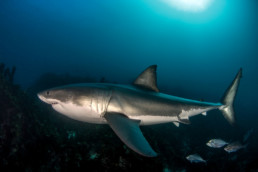
It may never have occurred to Julie Holowach, when she went for a swim off Bailey Island in the summer of 2020, that she would be attacked by a shark. But the 63-year-old summer resident was killed while swimming toward the mouth of Mackerel Cove, which opens to deeper water. Her incredibly unfortunate death was, as far as anyone knows, the only fatal shark attack ever in Maine waters.
Great white sharks historically are not commonly reported in the Gulf of Maine. After spiny dogfish, the next most frequently seen sharks here, in descending order of frequency, are the blue shark, basking shark (“a whale trapped inside the body of a shark,” as shark expert Greg Skomal puts it), shortfin mako, porbeagle, thresher, sand tiger, and least seen among these, the great white. But this has been changing recently.
Never reported often, the great white shark population is thought to have plummeted during the 1970s and ‘80s to about a quarter of what it was at the time I was dogfishing off Chebeague. They were getting caught in commercial fishing operations and had become a target for sport fishermen, due in part to their sudden infamy as the deep-sea killer in the 1975 movie Jaws.
As studies, though still sketchy, mounted showing the great white’s decline, the National Marine Fisheries Service in 1997 outlawed fishing for them. Between the fishing ban and being attracted by a resurgence of seals due partly to the Marine Mammal Protection Act passed in 1972, great white shark populations in the Gulf of Maine have been increasing in the 21st century. Eleven great whites were tagged by researchers off Nova Scotia in 2019.
Most of the world’s 513 living species of shark are migratory, and they have lived practically everywhere in the world’s oceans since the first ones—about a foot long—showed up 380 million years ago. Like every living thing on the planet, each shark species has its own preferred habitats and ranges, though these in general are not well understood so far.
The most common large shark in the North Atlantic is thought to be the blue shark (Prionace glauca, 7 to 12 feet in length at maturity), with numerous individuals tracked from Newfoundland down to the Caribbean and all across the Atlantic to Europe and West Africa. A great white shark tagged at a seal colony off South Africa traveled the Indian Ocean to Australia and back again, a round trip of about 12,000 miles, in less than nine months.
Along with their close relatives the skates and rays, sharks are elasmobranchs—a subclass of cartilaginous fish, whose skeletons are made of cartilage rather than bone proper, making their bodies light and flexible. Unlike most other fish, sharks, skates, and rays have no swim bladder for buoyancy, and must keep moving to stay afloat. Sharks have five to seven gill slits through which water has to flow for them to breathe, another reason they famously must keep moving forward.
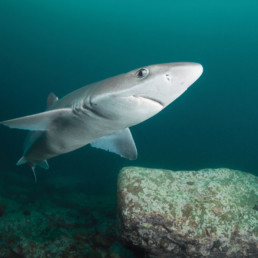
Shark skin is covered with tiny toothlike scales called denticles, which are pointed toward the tail; rub the skin toward the tail and it feels smooth, rub it toward the head, against the denticles, and it feels like sandpaper. Their powerful jaws are not part of the skull, enabling sharks to extend their mouths, in which are multiple rows of teeth. Some sharks’ teeth are molarlike, and others, like the great whites’, sharp, serrated triangles. Most sharks grow, lose, and regrow thousands of teeth over their lifetimes, which range from 30 years among sandbar sharks, to 80 for spiny dogfish, to upwards of a hundred among Greenland sharks. Some sharks lay eggs, though most, like great whites and spiny dogfish, give birth to live pups. They are relatively slow to mature, as fish go, and this, combined with fairly low reproductive rates overall, make them vulnerable to overfishing.
Sharks seem to see reasonably well in dusk-like light at short distances through their two eyes, which enable nearly 360-degree vision. Touch sensors provide information about water movement, and electroreceptors read electrical and magnetic fields, which they may use for navigation to breeding and feeding grounds. Their main perceptive faculty, though, is olfaction, scenting in acute detail prey, predators, and mates. Like much else concerning sharks, though, not a lot is understood about how this works.
Great white sharks (Carcharodon carcharias) are becoming better and better studied with improving tagging and satellite technology, but still pose many questions for researchers like Skomal, head of the Massachusetts Shark Research Program. Great whites are highly migratory. At least some return to the same feeding sites, eating mainly fish when younger and adding larger prey, including seals and dolphins, to their diet as they grow larger. But much remains to be discovered about them.
The attack on Julie Holowach was, by all accounts, almost certainly a matter of the shark mistaking her for a seal or sea lion. Skomal, in his Shark Handbook, notes that fewer than ten attacks of great white sharks on humans are reported per year. Even then, the shark almost never tries to eat the human, though the wounds can be severe enough to kill.
Worldwide, about 70 attacks by sharks of all kinds on humans are reported per year, with an estimated 25 to 50 unreported, and an average of four fatalities. According to the International Shark Attack File of the Florida Museum, there were 64 confirmed unprovoked shark attacks worldwide in 2019; five attacks resulted in deaths, two of which were classified as unprovoked.
Most shark attacks happen to surfers, as well as swimmers and divers, in Florida, Australia, Hawaii, South Africa, South Carolina, and California. About 38 percent of unprovoked shark attacks are by great whites, 13 percent by tiger sharks, and 12 percent by bull sharks, with those attacks resulting in death about 25 percent of the time.
Skomal’s research since 2009, including his recent focus on white shark predatory behavior off Cape Cod, indicates the great white shark population has been rising in New England waters; in 2019 he tagged 50 off Cape Cod, the most ever. Along with more sharks come more chances of close encounters with humans. Six unprovoked shark attacks have been reported in Massachusetts since 1837, according to the International Shark Attack File, five of them since 2012; the only two deaths were in 1936 and in 2018, when a boogie boarder was killed.
Fishermen have long been the best source of information about shark presences, whether reporting sightings or helping with tagging projects, and that is likely to be the case for a long time. Two Stonington lobstermen were hauling traps northeast of Isle au Haut in September 2020 when a shark followed one of the traps up out of the water and tried to bite it. The fish was 12 to 15 feet long and “as big around as a 55-gallon drum,” one of the men told a reporter. The shark rose up as if to make a second pass at the trap sitting on the boat’s gunnel, lurked around, and then swam off.
“It was startling, I guess,” one of the men said, with Downeast understatement almost as old as the elasmobranchs themselves.
What kind of shark went after the lobster trap was not known. The lobstermen said that earlier in the summer they’d seen dead seals with what might have been shark bites. It’s the kind of clue researchers can use to unlock the many unanswered questions about one of the world’s oldest, most mysterious, fascinating living beings.
Dana Wilde is a nature columnist, book reviewer, former news editor, and college professor. His recent books are A Backyard Book of Spiders in Maine and Winter: Notes and Numina from the Maine Woods. He lives in Troy.
An Old Salt, An Old Way of Life
An Old Salt, An Old Way of Life
Pulling a living from the cold, unforgiving sea
Story by Jon Keller & Illustrations by Leslie Bowman
Five degrees above zero and the diesel motor chugged. My fingers were wet and numb and my hands couldn’t work the clasp on the chain-link bag of mussels that hung dripping salt water and mud onto my hood, shoulders, and face. My blue vinyl gloves had already frozen into salt ice that crumbled as I worked. Two of my fingers were wedged inside the two-inch steel ring that was meant to serve as a release for the bag of mussels, but I couldn’t get it to release.
Spencer angled his shoulder into the mussels, tried to brace the bag against the rocking of the boat. The bag was a huge web-work of iron rings. Full of mussels and mud, it must’ve weighed over a ton. The bottom hung level with our chests, and it swung and slammed us against the plywood sorting table. Spencer hollered at me over the engine roar—I had to pull the goddamned clasp before we were pounded flat.
I crouched halfway beneath the bag, soaked, freezing cold. Everything was turning to ice, even the mud, and if any of the rusted cables or rusted fittings or old shitty-looking hydraulics on the drag malfunctioned, I’d be crushed.
Spencer stood off to the side. He wouldn’t go under the bag. He’d been working on a mussel dragger long enough. The guys who went under the bag kept quitting, so that was my job. Stand under the bag and pull the fucking ring.
The mussels were supposed to drop from the bag into a cylindrical steel cage called either a washer or a hopper. The washer was large enough to hold a horse if the horse had no legs and no head, and the entire apparatus was held to the stern of the boat by two hydraulic arms.
Finally the captain charged to the stern. He yelled and motioned for me to snap the ring to the side, not down or back or whatever way I was tugging on it. I yanked it hard and a charge of pain shot through my fingers and up my forearm and landed in my elbow.
The mussels dumped instantly, poured over the stern and into the ocean and onto my feet, banged everywhere with sharp metallic clinks. Spencer shouted and tried to position the bag over the washer. I tried to help. Everything was big and metal and mussels rained down like hailstones. Seaweed and mud and rocks—undersea rocks that weighed more than me—spilled from the bag and splashed into the washer.
I re-latched the bag and Chris, the captain, yelled, “Set?”
I turned and nodded to him. He was in the wheelhouse, enclosed by a shabby plywood affair that looked like it should have fallen over in a gust of wind ten years earlier. A rusty propane heater blasted at him. He worked a series of hydraulic levers with his left hand, fed himself powdered doughnuts with his right, and steered with his thumb or elbow or whatever was free.
He kept singing country songs in a loud, heartfelt manner. Any bad moves on the levers while singing and munching doughnuts—even a twitch as a wave hit—would mean that I, and probably Spencer too, were done. One slip totaling a fraction of an inch and we’d be gone.
Why I trusted Chris so completely, having just met him that morning, and having just watched him and Spencer do an apparently rehearsed air guitar routine as the boat’s engine warmed, was simply because I’d learned a little bit about where the two of them were from.
We’d left that morning from Alley Bay, a small cove off the eastern pitch of Beals Island. Both Spencer and Chris were Beals from Beals Island, and they’d both gone to Jonesport-Beals High School; Spencer was Chris’s uncle, although they were roughly the same age—early 40s. They were from a long line of boat builders and fishermen, and that’s what they did. They built boats and they fished boats and on weekends, they raced boats. Spencer’s father, Mariner Beal—Chris’s grandfather—remains a legend in Maine boatbuilding, and he and Spencer’s older (much older) brother Isaac—Chris’s father—had designed and built one of the iconic Maine lobster race boats: the Christopher.
From Alley Bay, we’d steamed east out of Moosabec Reach, which at its narrowest is a quarter-mile wide swath of water that separates Beals from the mainland. Beals had “settled” the island in 1775, but it wasn’t until 1958 that a bridge was built, a project inspired in part by the uncanny success of the Beals Island basketball team throughout the 1950s—kids wearing sea boots took wooden boats across the Reach in order to get to games that they won, one after another, year after year. They practiced in those sea boots, saved their sneakers for game-time, and became state champions.
We followed a series of ledges then cut northeast to duck into the Thoroughfare, a snaking deepwater channel winding between Roque Island and the two Spruce islands, Great and Little. The Thoroughfare water was calm, green, and the Old Salt was the only boat out, its engine noise echoing off the ledges as we passed.
The land on both sides squeezed like a canal. A lichen called usnea hung yellow-gray from spruce and fir branches and below those branches the smooth striations of the granite ledges flared pink in the cold morning light. I stood on the stern, my hands tucked in the bib of my orange oil pants, and watched the islands glide by, the smooth V of our wake rolling against the shoreline.
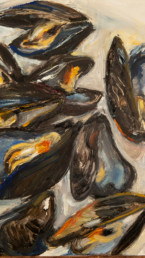
Once through the Thoroughfare, other islands blinked by—Double Shot and Anguilla and Halifax to the south, and beyond them the open ocean. To the north, the mile-long stretch of white sand beach on Roque Island. We crossed Englishman Bay and ran up the Little Kennebec River, the land once again closing in on us like framework. When we came to a sharp bend in the river, an old shingle-sided farmhouse off our starboard rail, Chris turned to us, nodded, and said, “Here we go, boys,” and with a flick of his wrist the drag dropped into the water.
Now the bag was out of the water and empty. Spencer and I latched our fingers into the iron rings and swung it back and forth to gain momentum. Then heaved. Chris worked the hydraulics, and as we let go, he released the cable and the empty bag plunged into the sea. Bubbles charged the surface. Mussel shells and flecks of seaweed—dulse, rockweed, kelp, sea lettuce—drifted in our wake. When the drag caught on the soft mud bottom, the boat lurched and the diesel chugged.
The sun cleared the tree line. Light spread over the river corridor and the temperature began to climb but my hands remained a mix of pain and numbness. I drummed them against my biceps, trying to beat the blood into flowing. Cold sweat traced my ribcage. The salt river was clear and green and cakes of ice the size of houses drifted with the current. An old wooden lobster boat hull lay on its side, derelict on the bank. The tide ran hard and pushed the Old Salt cockeyed, like a gull quartering into the wind.
With the washer full and the drag back on bottom, I thought we’d have a moment to collect ourselves, but Spencer pointed at the half-submerged washer and told me to climb over the stern and get into the washer.
“Got to pack them down,” he said. “To get the door closed.”
I thought he was kidding, but his face was serious and impatient, so I climbed over the stern—out of the boat—and stood atop the mussels in 35 degree seawater that nearly filled my rubber boots.
I held tight to the stern. Propwash shot from the propeller, rose in surges around my ankles. On either side of me, deep green water slid by; a half step back and I would be in the ocean. It was like waterskiing behind a dragger in the dead of winter.
In the boat, Spencer pulled seaweed from his beard. Chris, at the helm, sang and played air guitar, using a pinch of doughnut as a pick.
I stamped the mussels down, sinking into hollow spots that nearly pulled my boots from my feet. Above and behind me, the drag cable danced and sparks of water shot from its taut steel strands. Our wake rose like banks of earth, and the boat lurched and pulled against underwater rocks and ledges, mud pockets and shell heaps.
When I finished, I climbed back into the boat and braced my pelvis against the stern, hung over the edge and flipped the door closed. I pulled the latch tight and gave Chris a thumbs-up. The washer lowered into the water and began to spin, a great plume of mud erupting in its path.
I’d met Spencer two years earlier. I was a sternman on a lobster boat, and the captain I worked for had hired Spencer to do some fiberglass repair work on the boat. He and his wife showed up in a rusty Oldsmobile with a license plate that read MamaTrd.
Spencer was stocky, broad-shouldered, bearded. He wore thick glasses, sweatpants and sweatshirt, old slippers, and a baseball hat so covered with bits of mud and seaweed and fiberglass dust that whatever it had once said had long ago been rendered illegible. His wife waited in the car while he looked the boat over; he didn’t say much, only nodded and said, “Yup,” once in awhile.
Months later, I stopped by his boat shop. The shop, called Uncle Bunk’s Boat Shop, was a galvanized Quonset hut he’d salvaged from an old movie rental place called Mrs. Big John’s.
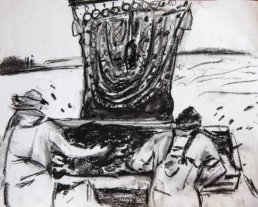
The sign (Mrs. Big John’s Video) still hung inside, each block letter nearly two feet tall. Built in the Downeast style—a hodgepodge of salvaged materials—Spencer’s shop wouldn’t pass code by any stretch of the imagination, and as I stood there, I had to wait while he cut away several structural roof trusses with a chainsaw in order to fit a 40-foot lobster boat inside for winter repair work.
A refrigerator that wasn’t plugged in stood next to an unplumbed toilet. The refrigerator door hung open, a half-empty box of Busch beer inside. Everything—work benches, old hulls, wood scraps, lobster traps, saw horses, boat stands, rope coils (called pot warps)—was covered in a layer of fiberglass dust as if it had just snowed; you could track where people had walked, could tell which tools had been used that day, which had sat for a matter of time, and you could taste the fiberglass on your tongue, feel it in your nose, sense it on your skin like a toxic layer of salt.
I continued to stop by Spencer’s shop. He’d hand me a warm can of Busch from the refrigerator, say, “There’s always room for dessert,” and then show me what project he was working on.
He did a lot of the fiberglass work for the local lobster fleet. I’d drink my beer and ask questions about hulls and boat builders, and soon Spencer would get talking about the days when he was a kid out on Beals Island, hanging around his father’s boat shop, the days when the modern lobster boat was evolving at the hands of men like his father, Mariner Beal, and his uncle, Vinal Beal, and their neighbors, names that are now famous in the lobster industry—Harold Gower, Clinton Beal, Calvin Beal, Ernest Libby.
That winter, when I worked aboard the Old Salt, Spencer would call once in a while and ask if I wanted to go for a car ride with him to look at a lobster boat somewhere on the coast. He was a marine surveyor, and he’d have a boat to survey in Stonington or somewhere on Mount Desert Island, and I’d ride along with him.
I’d hang around as Spencer conducted his survey on one boat or another, and I’d ask about lobster boat design and construction. He’d talk about the sheer lines, the flare in the bow, the shape of the stern and keel. He knew every boat model, boat designer, and boat builder on the coast of Maine—and most times, he knew individual hulls, who’d owned it, worked or raced it, modified or wrecked or sold it.
I followed Spencer into the wheelhouse. It was a Dwight Yoakum tune that Chris was working on—maybe someday I’ll be strong, maybe it won’t be long…the half-eaten bag of doughnuts in front of him, powder on his lips. Spencer opened a package of chocolate and cream Ding Dongs and a can of Coke. He hummed along with Chris’s tune as he chewed, drummed away at the air with his free hand. His beard was still caked with mud and seaweed. His black rain jacket hung in absolute shreds, exposing a gray sweatshirt that was already soaked through.
I wore a newer version of the same black rain jacket but my hood was up because I’d been beneath the drag. My head and face and shoulders and chest were covered in so much mud and seaweed and water that I could feel the simple weight of it all. I wiped at the mud on my face, but it was fruitless. I tried to warm my fingers at the heater but I didn’t have time to take my gloves off because to take my gloves off meant taking my jacket off first because the gloves had to be tucked under my cuffs and sealed tight to keep water from running in. So I stood and waited while they sang and ate.
Minutes later, the washer rose into the air and the thick mussel shells rapped together in a deafening clatter. Empty shells and rocks and whelks and wrinkles and urchins and broken ends of seaweed catapulted from the steel cage.
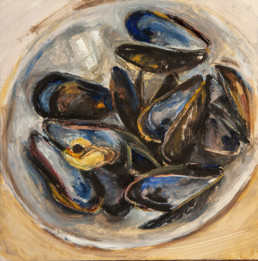
I followed Spencer out of the relative heat of the of wheelhouse as Chris lowered the mussels for one more seawater rinse. We stood at the sorting table—it was a nearly collapsed plywood table, divided into two sorting sections—as the washer stopped with the door facing us, and Spencer pointed to the lever that would release the door. He nodded to me. I jerked the lever, but I couldn’t move it. It was a bent piece of steel the size of my forearm.
I turned and saw Chris and Spencer exchange a glance. I pulled harder, finally threw my weight into it and the door smashed open with a huge thud and the mussels burst out and dumped over the 4-foot-by-8-foot table. I shut the door, and Chris worked the hydraulics that maneuvered the washer back over the stern.
Spencer and I sorted the mussels; rocks and broken mussels and sticks and trash and other shellfish—lobsters, scallops, whelks, urchins—went over the side; good mussels, their shells bluish-black, sleek and shining, went into bushel onion bags that hung from nails at our waists. There was no time to be picky; it was about speed, hand and eye coordination, dexterity. Any rocks or debris we missed would be removed at the processor before the mussels were shipped.
Of course, I was too slow, too picky, so Chris let the boat hold its own course and gently pushed me out of the way and began working his hands over the mussels at a dizzying pace. It was as if one eye led one hand, the other eye the other hand—both hands picked up rocks and sticks and junk at the same time, so like a juggler, at any moment there were a half dozen pieces of debris flying overboard while handfuls of mussels simultaneously slid into the bag.
When he had the bag full, he pulled it from the nail at the table’s edge, tossed two half-hitches over it like a calf roper, and carried the 60-pound bag to the wheelhouse, where he dropped it on the floor.
“Jesus,” I said to Spencer, who was tying his first bushel bag.
“We been doing it awhile,” Spencer said. “Since we was kids. He’s good.”
Two hours later, Chris put ten pounds of mussels in an onion bag and hung the bag in the boat’s hot tank, which was a 35-gallon barrel of seawater heated by the engine. A while later, he pulled the bag out and dumped the cooked mussels onto the wash rail. Spencer and I finished clearing the table where we’d been sorting, and Chris turned the boat down-tide so that the drag worked like a stern-first anchor. We sat on the wash rail and ate mussels, the flesh deep orange in the sun, and flicked the shells overboard as we ate.
By the end of the day we had 130 bushels—almost 8,000 pounds—of mussels piled aboard the 37-foot boat, and I could feel the weight in her cumbersome pitch and roll as we crossed Englishman Bay. The purple bushel bags filled the wheelhouse, surrounded Chris up to his shoulders, and lined the starboard rail all the way to the bow.
The wind had lifted from the southeast while we were dragging the river, and now Chris piloted the Old Salt slowly, angling offshore toward Halifax Island to take the swell on the quarter instead of the beam. Frigid spray pummeled the windshield and spilled from the wheelhouse roof. I watched Chris carefully, told myself that the fact that he hadn’t stopped singing and playing air guitar was a sign that the over-loaded boat was still relatively safe.
In the lee of Halifax, Chris cut the wheel and turned the boat 90 degrees to follow a course northwest toward Lakeman Island, letting the swell take us on the stern quarter. Waves slapped hard against the hull, sending sprays of water into the air, high into the dragger’s A-frame.
The water calmed as we neared Lakeman, then flattened to a Bahama-like turquoise as we entered the Thoroughfare. We followed the southern shore of Roque Island in silence, save for the ceaseless grinding of the diesel engine. We crossed Chandler’s Bay, and Chris again angled us out to sea, keeping the swell on the quarter, then cut back into the protection of the Reach, our entire path like a series of mile-long Z’s through the water.
As we ran up Moosabec Reach, Chris cut the boat north toward the wharf and like a car fishtailing on ice the boat twisted at an angle to the rushing tide.
We tied to the wharf pylons. I looked overboard at the clear, shallow water. Behind me, Spencer lifted a rock the size of a basketball off the floor of the Old Salt—it had come up in the drag and no one had bothered to throw it back overboard—and heaved it beneath the wharf, onto an existing pile of rocks.
He looked at me with a sheepish grin. “That’s my pile,” he said. “Been throwing rocks there for years.”
I stared at the pile. I shook my head in disbelief. The pile looked like it would have taken an excavator and a dump truck to build, but it was just one man and many years.
The tide was nearly low. The men in orange oil gear on top of the wharf stood 25 feet above us. Chris climbed the long, greasy ladder, and Spencer and I stayed on the boat. We spread a length of heavy line across the deck and stacked ten bags of mussels perpendicular across it, then cinched it tight. From up on the wharf, Chris worked an electric winch that lifted the bags up to the wooden wharf deck, where a forklift and refrigerator truck waited.
Spencer grabbed my elbow and pulled me off to the side. “Trust me,” he said, pointing to the 600 pounds of mussels dripping and spinning in the air above us. “You don’t want to be under if she slips. And she does slip.”
Bag by bag, Spencer and I tied-off all 130 bushels. Chris and the dock crew stacked them on pallets and wrapped them with clear plastic wrap then used a forklift to load the pallets into the truck that would take them the to the processor. Chris was paid $5.50 for each bushel bag—less than ten cents a pound. From that, he paid his father for the use of the boat, paid for fuel and maintenance, and paid Spencer and I, who each got $.90 per bag.
Chris’s father—Spencer’s brother—Isaac, waited for us in his truck. He looked like an old salt himself, like one might envision a two-legged Ahab: the captain’s hat cocked at an angle on his head, the trimmed white beard, the red weathered skin. He nodded to me but spoke only to Chris and Spencer.
I turned and watched a line of swell edge across Alley Bay. The small fleet of lobster boats twisted and rocked on their moorings, their noses pointed toward wind and tide, their hulls as smooth and graceful as the swell that rocked them. I thought of the speed of Chris’s hands as he tossed shells and rocks overboard, and of Spencer’s rock pile beneath the wharf, and of all the stories he’d told me about the island’s boat builders.
I turned my back to the water. Spencer and Chris and Isaac were standing next to the truck, talking about boats and fishing beside the same bay their ancestors had stood beside for centuries.
A cast of gulls swooped overhead. Behind the three men, old boats and piles of lobster traps lined the narrow street. I pictured the underwater fields of mussels, oblivious to the vast swirl of sea around them, simply holding fast to some rock.
Spencer turned onto a side street. He pointed out the house he’d grown up in, the dilapidated shop where he’d watched his father build so many wooden boats. We passed Isaac’s home and stopped at the end of the road. Spencer let the truck idle. A field sloped in front of us, leading down to a rocky beach. There wasn’t any snow on the ground, only patches of ice and frost. After a while, Spencer said, “I used to sled right here when I was a kid.”
I waited for more, but he didn’t say anything more. I looked at the farmhouse that fronted the ocean beside the beach, and at the conspicuous car with the out-of-state license plate, and I thought about how much this place of Spencer’s must have changed in the 40-some-odd years Spencer had been alive.
Then I thought of how much it had not changed.
I glanced at Spencer. He stared at the field as though some memory were flooding his vision. I looked at the field and pictured him sledding, his huge shoulders and sprawling beard, and I found myself smiling, an image now flooding my vision, too: this big, kind, bearded fisherman and boat builder, a generation younger than his brother, sledding down a field on a remote island in Maine, rubber boots and hooded sweatshirt on, headed, as always, for the ocean.
Spencer Beal died from leukemia in 2018.
Jon Keller is the author of the novel Of Sea and Cloud. He writes and digs clams in Downeast Maine. Leslie Bowman is a photographer and painter who lives in Trescott.
Island Gallery Owner is Buyer, Artist Matchmaker
Island Gallery Owner is Buyer, Artist Matchmaker
Elaine Crossman marks 20 years with New Era Gallery on Vinalhaven
Story by Tom Groening and Photos by William Trevaskis
No one on Vinalhaven objects to thousands of pounds of lobster heading to the mainland each summer. After all, that export is the economic lifeblood of this island.
But Elaine Crossman saw another export heading for the mainland and thought she should do something to interrupt it. That export was art—paintings, sculpture, photography—and having it displayed and sold on-island is one of the reasons she gives for starting New Era Gallery, now in its 20th year.
Crossman, a painter and printmaker herself, displays and sells the work of many seasonal and year-round artists—who could happily and prosperously limit their sales to urban galleries—and finds willing buyers among other seasonal and year-round islanders.
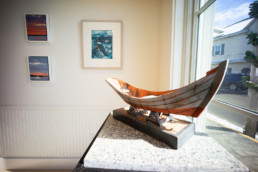
She took time out on a late winter afternoon to reflect on the success she’s been able to achieve in this fishing town. Perhaps the biggest key to that success is that she straddles both the creative and business worlds, since she is both artist and entrepreneur, a formally trained painter and a long-time year-round islander.
And those perspectives are not separate: “I run the gallery the same way I construct a painting,” she explains. During a tour of the space, she shows how paintings and three-dimensional pieces are grouped around a color, subject, or texture theme. The effect is subtle and pleasing to the eye.
A theme also emerges as Crossman recounts the journey that led to the island and this gallery.
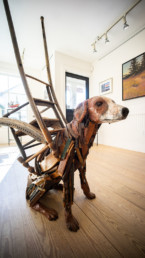
After growing up in South Reading, Vermont, a small rural town where her family roots extend back to the 1700s, she attended the University of Pennsylvania in Philadelphia, eventually earning a Master of Fine Arts degree. But Philly wasn’t a good fit, at least in the early 1970s.
“It was a very violent city, a very crime-ridden city,” Crossman remembers. She landed on Vinalhaven in 1976.
Not surprisingly, the island changed her aesthetic sensibilities.
“I did a lot of interiors for a lot of years,” she remembers, and what she describes as semi-abstract prints. “I continued to work in landscapes, but not very seriously until I came out here. You set foot in this place and you think, ‘How can I not?’” Winter is especially powerful in its lonelier mood.
“There’s nothing between you and those elements of rock, water, and sky.”
The island is more than a subject to be rendered in paint, she says. “It’s not just physically beautiful. It’s also deeply compelling.”
The gallery was born in 2002, the year Crossman’s daughter left to attend college. She’d had a good year selling her work in a couple of mainland galleries, and “I was turning 50,” she says with a laugh. But it was more than those forces conspiring.
“I had seen a steady stream of art going back across the bay to be sold in mainland galleries,” and she thought, “What if I cast a net into that stream?” She also was committed to helping boost the town. “It needs to be a part of Main Street, and Main Street culture.”
The gallery began in a small building that fronted on Main Street; then in 2007, she was driving by what had been a vacant lot a few doors down and saw a building under construction. It was a now or never moment, as the center wall was in the midst of being framed, and Crossman took the plunge.
That center wall is non-existent, allowing for two separate, though small, wings. Later, she added display space in a barn behind the gallery and a sculpture garden.
Though its domain is rooted in the creative, a gallery is very much a business; at its most basic, it is an art store, not a museum. But that store features the work of people who create far from the gallery and heed their own muses. The customers, too, are not stopping by to pick up a postcard or even a piece of furniture for a guest room. Art is a very personal choice.
Crossman’s approach to choosing what to feature is both gut-level and carefully considered.
“I have to love it. The price also has to be right. And it has to be someone I can work with,” and so she sees herself as a sort of matchmaker.

Perhaps the most remarkable dynamic at play at New Era is that this matchmaker role has her welcoming and including seasonal artists, some of whom have work in the permanent collections of world-class museums, to sell some of their work here. In all, she features the work of some 70 artists.
And just as important is her ability to find those year-round and seasonal residents who are able to buy art without batting an eye.
Some of those buyers might not stand out if they stroll by on the sidewalk, she says, and that’s because they enjoy the low-key informality of Vinalhaven. Crossman is committed to honoring their wishes to remain somewhat anonymous.
“It’s an interesting dance. The buying community I work with is really interested in supporting our art community.” When they come into the gallery, “The first question is not, ‘What am I looking at?’ It’s ‘Who is this?’”
Along with the pleasingly resonant groupings, a stroll around the gallery reveals work that is accessible yet strong. In response to a lingering eye over this print and that painting, Crossman asserts that “Every piece of art in here is worthy of someone’s attention.”
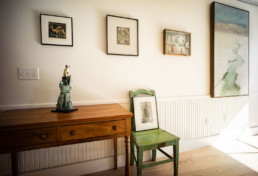
Since the pandemic, she has had to learn new skills in connecting artist with buyer. An Island Institute grant helped her create a new website, and video and other tools are helping her “reach out beyond these four walls.”
Crossman is bullish on this summer, planning on five shows, beginning Memorial Day Weekend.
Near the end of our conversation, she shares what she considers the highest of compliments for New Era Gallery, someone who observed: “I would feel differently about this community if the gallery weren’t here.”
Tom Groening is editor of Island Journal. William Trevaskis lives on North Haven and teaches music on Vinalhaven.
The Island’s Star
The Island’s Star
Vinalhaven carries Robert Indiana’s artistic legacy forward
STORY BY PHIL CROSSMAN PHOTOS BY SHERI ROMER
In 1933 while he was in the first grade, Robert Clark created a painting for a beloved teacher. Forty years later, after his iconic LOVE image swept, un-copyrighted and thus less fulfillingly than might have otherwise been the case, through the graphic world of publishing, television, movies, postage stamps, sculpture, record jackets, and greeting cards, he, now Robert Indiana, invited her to visit him in his New York City studio. She’d been wise to have kept the painting.
For a while, particularly after visiting the palatial state house in Indianapolis as a youngster, Bob had wanted to be an architect, and while the required math obstructed his interest, admiration of structure and design was never far from his heart.
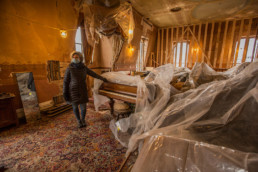
Years later, when the ferry carrying him and his host, famed Life magazine photographer Eliot Elisofon, swung into Carver’s Harbor on Vinalhaven Island, it was the sight of a magnificent three-story building in the center of the village that captured his attention.
Known today as the Star of Hope—Bob’s designation—it was a majestic structure, a testament to the opulence of Second Empire Victorian design and was then the home lodge of the Independent Order of Oddfellows. It, and another nearly identical building, the Masonic Hall, stood like devoted sentinels on both sides of the Memorial Hall, a building just as imposing but lacking the distinctive mansard. The three lorded regally over the island’s Main Street.
The Memorial Hall, home to all that was communal on Vinalhaven, was torn down in 1973, having fallen victim to some heart-wrenching shortsightedness but, it must be acknowledged, also to the enormous cost of upkeep. The Masonic Hall had burned six years earlier.
A number of subtleties distinguish a Second Empire from a conventional mansard roof. Those that distinguished Bob Indiana from most other islanders were less subtle. He was gay, not very quiet about it, yet reclusive. And melodramatic, if often simply in the service of drama.
Elisofon ultimately purchased the Star of Hope from the lodge, which had been inactive for several decades, rented it to Bob, and later he was invited to buy it. He was by then a renowned pop artist on a par with and an acquaintance of such stars of the genre and time as Andy Warhol, Roy Lichtenstein, and Jasper Johns.
Bob occupied the second and third floors just as the old order had and used the two big first floor former storefronts as workspace and storage for his rapidly accumulating trove of creation and similarly amassing accolades.
By the early 2000s the Star of Hope Lodge was consumed by Bob’s presence and creativity. He was honored by the Whitney Museum in New York City with a retrospective of his work, an event, given the long-ago misappropriation of LOVE, he characterized ironically as “Forty Years Too Late.”
Still, Robert Indiana described himself “at ease” with his place in art history and with his place here in this community, and his own peculiar occupancy of a place called the Odd Fellows Hall was never lost on him.

As Bob and his residency wore on, so did the building he loved. During his last exceedingly cloistered decade, it deteriorated very badly, to such an extent that pigeons, four-legged critters, and, most damaging, rainwater, each finding increasingly easy access, were accelerating rot and deterioration.
Bob died in 2018, but two years earlier had left a will creating the Star of Hope Foundation, leaving his considerable estate to it and prescribing that the building become “an art environment, open to the public…” The foundation had three directors.
When he died, the board found itself one shy of that requisite minimum and Maine’s attorney general, concerned about the irresponsible disposition of assets and that Bob’s wishes be adhered to, asked Larry Sterrs, a man with a long and successful record of non-profit management here in Maine, to help out.
Bob’s death quickly and unfortunately precipitated the initiation of much—some clearly covetous—litigation, a growing accumulation of obstruction that stood in the way of implementing Bob’s wishes and of the critically urgent need for beginning work on the building while there was still time to save it.
The board, now comprising Sterrs and two new members, Vinalhaven real estate agent and native Kris Davidson, and Patricia King, vice president of Waterville Creates and former associate director of the Colby College Museum of Art, focused first on the need to stabilize the deteriorating building so serious restoration could begin.
Plan A, then, was to get the foundation, sole beneficiary, up and running and immersed in the varied litigation in an effort to promote enough accommodation among litigants that stabilization could begin.
Although there’d been an initial examination, the foundation soon discovered that water damage and resultant loss of structural integrity was much worse than first understood, such that the building was in danger of bursting from its skeletal remains.
On a memorable and discouraging day in December of 2019, workers exposed an interior wall and discovered a corner post, one of several responsible for holding aloft the massive three stories above, was, as were the others, completely rotted. A much more demanding effort was required to achieve the desired stabilization and it was not until March of 2020 that the foundation could declare it was making progress instead of simply stemming deterioration.
Another discovery, not troubling but certainly surprising, revealed itself when the two ground floor levels, east and west, were found to be at significantly different elevations. Apparently, the Oddfellows, having perhaps occupied only the modest second floor of a simple gabled building on the same spot since 1885, had, in 1896, acquired a similar building next door, then joined the two by topping them with the third story mansard and a grand entrance and stairway between—quite a feat. The order’s home suddenly assumed truly majestic proportions, entirely appropriate and in keeping with the group’s royal proceedings and serving them well until the 1930s when membership began to dwindle.
Eventually, after a year or so of work involving vastly more structure-saving stabilization than had been anticipated, the Star of Hope is today nearly ready for stage II. This will continue to be a labor of love, one that is clearly regarded as such by Rockport Builders, the workers who have accomplished this special work, and by a deeply appreciative and grateful community.
Phil Crossman is one of Vinalhaven’s oldest citizens, which is really not saying much given the number of elderly in residence. Other than that, he serves on the town select board; has authored four books, including his last which recalls his first time (kiss, that is); writes a regular column for The Working Waterfront and The Wind; and owns the Tidewater Motel.
Phil Crossman is one of Vinalhaven’s oldest citizens, which is really not saying much given the number of elderly in residence. Other than that, he serves on the town select board; has authored four books, including his last which recalls his first time (kiss, that is); writes a regular column for The Working Waterfront and The Wind; and owns the Tidewater Motel.
Sarah Brake - An Island's Human Resource
Sarah Brake – An Island’s Human Resource
Young mother moves to Frenchboro, putting hospital career on hold
By Casey Engelman
When Sarah Brake first moved to Frenchboro in 2014, she didn’t think it was a good idea. At all.
“I was terrified when I first moved to the island, didn’t think I was going to make it whatsoever. Island life isn’t easy.”
Seven years and one pandemic later, Brake, 29, is still living on the island, and her fears have been proven wrong. She has become a fixture in the workings of the Frenchboro community, wearing many hats, including that of a member of the island’s select board.
The path to island life wasn’t apparent early on. After growing up in Kittery, she pursued a degree in human administration in Missouri, her goal to work in human resources at a hospital.
“I liked the idea of the involvement with the people. It’s what interested me most—the on-boarding, the idea of hiring somebody and trying to figure out why they might be a good fit for a job—it was really intriguing to me,” she says. The work seemed like a living, breathing puzzle, where the right piece needed to be found for the right gap. That passion transferred to a passionate pursuit of work, as she balanced three jobs with her studies, taking on apprenticeships and eventually finishing her degree online.
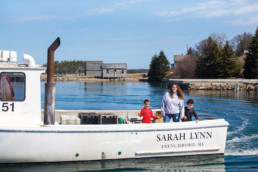
Then in 2014, Brake became pregnant with her first son. She moved back to Kittery to live with her parents. Her fiancé, Danny, with whom she’d grown up in Kittery, had moved to Frenchboro to continue his work as a lobsterman. Though she was initially apprehensive, she finally made the move to the island, prioritizing their family life and Danny’s career.
“I could have stayed in Kittery and he would have come and visited us when he could,” she says. “If I had made that choice, he would move off-island, but he’s been lobstering for some time. The best place for him was Frenchboro—it was where he could get his license first, it is where he could thrive.”
She made the move to the island in October, a bold choice for someone who hadn’t yet experienced island living.
“I do not recommend moving out to an island in the winter,” she says now. “The whole first winter I didn’t really get out much, I didn’t know a lot of people so I kind of stayed in my own little home.”
With the arrival of warm weather in June, islander Kim Smith approached Brake about joining the select board, seeing her education as an attractive asset.
“She thought it might give me something to do, something to look forward to.”
Though she didn’t yet know what the responsibilities were, Brake jumped in, attending meetings and quickly gaining a spot on the board, employing the skills acquired during college and apprenticeships. Members have changed through the years, but since 2014, the board has been comprised almost exclusively of those under the age of 30.
Brake marks passage of the island’s comprehensive plan as the board’s biggest accomplishment in her time. Frenchboro was almost 20 years overdue on passing a plan, something typically updated every ten years.
“The reason it is important is it states goals, what your town is moving towards,” she explains. “If it isn’t eventually passed it can hurt the town’s ability to apply for grants. It kind of holds back a town’s potential if you don’t have a comprehensive plan.”
Differing perspectives can lead to misunderstanding and conflict, but she and others worked to draft a simple and straightforward plan all islanders could accept. She partnered with Island Fellow Zain Padamsee to get the plan passed.
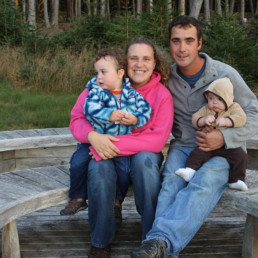
Beyond her role on the select board, Brake works at the post office three days a week, helps clean rental houses during the busy summer tourist season, and every other summer, greets visitors and sells them sandwiches and refreshments at Lunt’s Dockside Deli.
And she is the mother of two sons, a role that has its own island quirks.
Brake says it is challenging raising children on an island, but the positives far outweigh the negatives. Among the benefits are inclusion in the Outer Island Teaching & Learning Collaborative that brings together students from neighboring islands to learn together and form friendships, and the multi-age peers and companionship her sons get.
“We have the most amazing teacher on the island who really focuses on each child’s interests,” she says. “My son loves science and because he’s one of three kids in the school, it is so tailored to him. They also learn to play well with kids that aren’t their age, which is something that totally gets lost on the mainland. The education that my kid is getting is so much more than just school lessons.”
Though she admits that for now, she has had to put a career in human resources on hold, Brake says her move to the island has rewarded her in ways she did not expect.
“In college I just wanted to work, but I wasn’t seeing friends, I wasn’t talking to people, I was working 24-7,” she says. “Coming out here made me re-focus, re-center. Living out here you get to know yourself, learn about yourself, figure yourself out.”
In regaining that focus, she has also been able to hone in on the progress and vision for the island she has come to call home.
“You move to an island because it is little, or you have your independence. You have all of these people who think they know best and they want the best. What we all need to realize is that we all want the best. I want to find a way for us all to best work together—though our ideas may be different, I want to encourage people to listen with more open ears.”
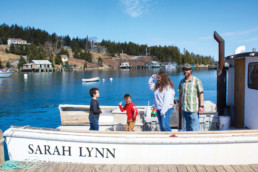
For now, she’ll continue with that work and enjoy the qualities of island life she has learned to love, like taking a hike on the Yellowhead Trail, where in 2022 she and Danny plan on getting married.
“It has both views, Acadia on one side and the open ocean on the other.” she says. “It puts everything into perspective—the world is huge, and we’re just on this rock in the ocean. You really get to be who you want to be out here.”
Casey Engelman is a recent transplant to the Midcoast. She attended Indiana University, where she studied journalism and food anthropology, and often employs both disciplines in discovering the treasures of everyday life to create her stories. She is a partner in Stone’s Throw catering, based in Rockport.

